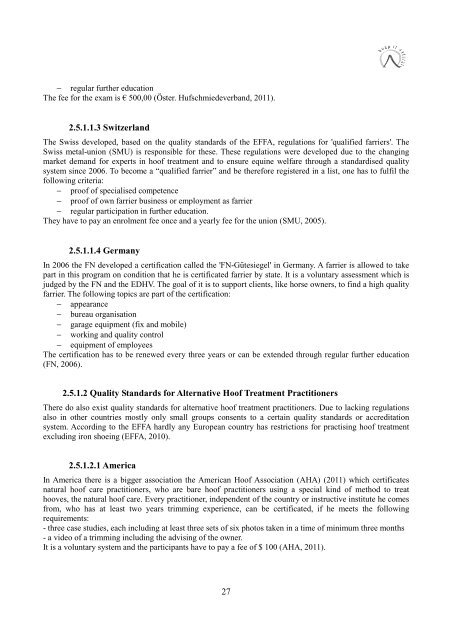Bachelor Thesis - Christina Kuenen - Hufpfleger
Bachelor Thesis - Christina Kuenen - Hufpfleger
Bachelor Thesis - Christina Kuenen - Hufpfleger
You also want an ePaper? Increase the reach of your titles
YUMPU automatically turns print PDFs into web optimized ePapers that Google loves.
− regular further education<br />
The fee for the exam is € 500,00 (Öster. Hufschmiedeverband, 2011).<br />
2.5.1.1.3 Switzerland<br />
The Swiss developed, based on the quality standards of the EFFA, regulations for 'qualified farriers'. The<br />
Swiss metal-union (SMU) is responsible for these. These regulations were developed due to the changing<br />
market demand for experts in hoof treatment and to ensure equine welfare through a standardised quality<br />
system since 2006. To become a “qualified farrier” and be therefore registered in a list, one has to fulfil the<br />
following criteria:<br />
− proof of specialised competence<br />
− proof of own farrier business or employment as farrier<br />
− regular participation in further education.<br />
They have to pay an enrolment fee once and a yearly fee for the union (SMU, 2005).<br />
2.5.1.1.4 Germany<br />
In 2006 the FN developed a certification called the 'FN-Gütesiegel' in Germany. A farrier is allowed to take<br />
part in this program on condition that he is certificated farrier by state. It is a voluntary assessment which is<br />
judged by the FN and the EDHV. The goal of it is to support clients, like horse owners, to find a high quality<br />
farrier. The following topics are part of the certification:<br />
− appearance<br />
− bureau organisation<br />
− garage equipment (fix and mobile)<br />
− working and quality control<br />
− equipment of employees<br />
The certification has to be renewed every three years or can be extended through regular further education<br />
(FN, 2006).<br />
2.5.1.2 Quality Standards for Alternative Hoof Treatment Practitioners<br />
There do also exist quality standards for alternative hoof treatment practitioners. Due to lacking regulations<br />
also in other countries mostly only small groups consents to a certain quality standards or accreditation<br />
system. According to the EFFA hardly any European country has restrictions for practising hoof treatment<br />
excluding iron shoeing (EFFA, 2010).<br />
2.5.1.2.1 America<br />
In America there is a bigger association the American Hoof Association (AHA) (2011) which certificates<br />
natural hoof care practitioners, who are bare hoof practitioners using a special kind of method to treat<br />
hooves, the natural hoof care. Every practitioner, independent of the country or instructive institute he comes<br />
from, who has at least two years trimming experience, can be certificated, if he meets the following<br />
requirements:<br />
- three case studies, each including at least three sets of six photos taken in a time of minimum three months<br />
- a video of a trimming including the advising of the owner.<br />
It is a voluntary system and the participants have to pay a fee of $ 100 (AHA, 2011).<br />
27


